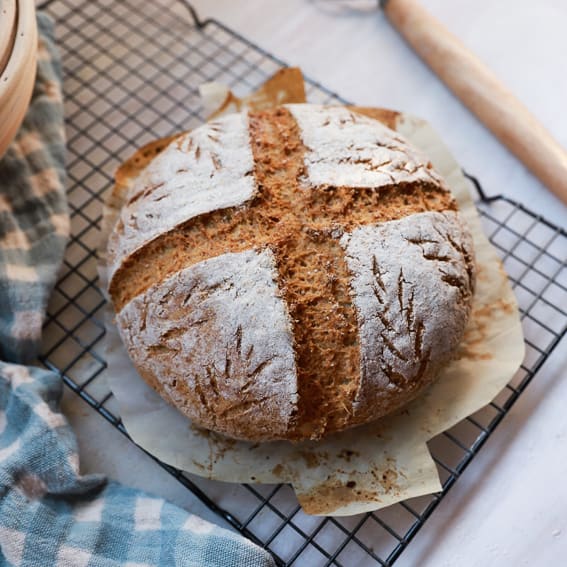Steam-Baked Gluten-Free Artisan Bread

Mary Thompson
October 28, 2022
This gluten-free bread has a crispy crust and a delicious and soft interior thanks to steam injection in the Anova Precision Oven. Steam keeps the moisture in the bread, preventing a hard crust from forming in the initial phase of baking and allowing for greater oven spring.
Notes: We strongly recommend using a scale to measure the ingredients for this recipe. This recipe uses quick rise, instant yeast. Make sure you find a gluten-free yeast.
Serves
8
Prep Time
00:45
Cook Time
00:45

5 (2)
1578
Ingredients
100 g (about 1 cup)
sorghum flour
100 g (¾ cup)
brown rice flour
90 g (½ cup plus 1½ Tbsp)
potato starch
80 g (½ cup plus 2 Tbsp)
tapioca starch
70 g (½ cup plus 7¼ tsp)
millet flour
45 g (⅓ cup plus 1 Tbsp)
quinoa flour
16 g (1 Tbsp plus 1¾ tsp)
instant yeast
¼ tsp
caraway seeds
470 g (scant 2 ½ cups)
warm water
23 g (¼ cup plus 1 tsp)
whole psyllium husk (not psyllium husk powder)
20 g (1 Tbsp)
maple syrup
15 g (1 Tbsp)
extra-virgin olive oil
7 g (2¼ tsp)
kosher salt
Extra brown rice flour for shaping and dusting
Steps
1. Mix Dough
In a large bowl, whisk together all of the flours with the yeast and caraway seeds. In a medium bowl, whisk together the water and psyllium husk until well combined with no lumps. Whisk in the maple syrup, olive oil, and salt. Add the water mixture to the flour mixture and stir until there is no loose flour. Let rest for 5 minutes.

2. Knead and Shape Dough
Dust a 7-inch round banneton (or bowl lined with a tea towel) with brown rice flour. Dust the counter with additional brown rice flour.
Transfer the dough to the counter and knead until it is easily shaped into a ball and is somewhat smooth on the surface, about 2 minutes. Transfer the dough to the banneton with the seam side up.

3. Let Proof
Cover loosely and let rise in a warm place 22 to 28°C (72 to 80°F) until doubled in size, 30 to 45 minutes. Do not overproof! Gluten free doughs are better to go into the oven sooner than later to get any oven spring.
4. Preheat the Oven
Rack
While the dough is proofing, place a cast iron skillet, pizza stone, or baking steel on the bottom rack of the oven. If using a skillet, cut a parchment round to fit the bottom of the skillet. Turn on the oven to heat.
Sous Vide Mode: Off
Steam: 100%
Temp: 424°F
Heat: Rear
5. Score Loaf
Once the dough has proofed, place the parchment paper round on the dough, still in the banneton. With your hand supporting the paper and the dough, gently flip the banneton upside down. Remove the banneton from the dough. (If using a stone or steel, flip the dough out onto a piece of parchment on an overturned sheet pan or pizza peel.
Sprinkle a little water over the top of the dough with water using your hand and sprinkle on some brown rice flour. Score a pattern with a lame or razor blade.

6. Steam-Bake Loaf
Rack
Carefully remove the hot skillet from the oven and gently place the paper with the dough into the skillet. Carefully place the skillet and dough into the oven. (If using a stone or steel, gently slide the dough, still on the parchment, onto the stone.) Bake for 20 minutes with steam.
Sous Vide Mode: Off
Steam: 100%
Temp: 424°F
Heat: Rear
00:20 Timer
7. Brown Loaf
Rack
After the steaming timer goes off, the oven will automatically reduce to 190°C (375°F) with no steam. Continue to bake until the dough is no longer soft on top and the bottom sounds hollow, 25 to 30 minutes.
Sous Vide Mode: Off
Steam: Off
Temp: 374°F
Heat: Rear
00:25 Timer
8. Cool and Serve
Cool the bread for at least 20 minutes before slicing. Wrap any leftover bread in beeswax cloth and leave it on the counter for two or three days before slicing and freezing the remainder.

© 2013 - 2025 Anova Applied Electronics, Inc.